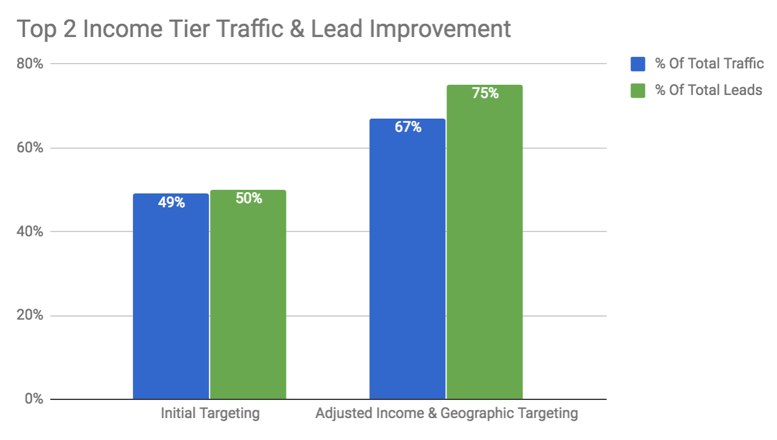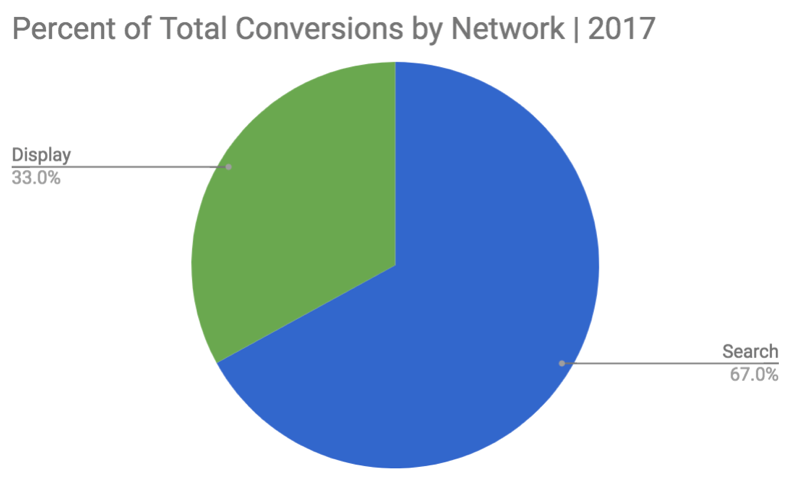With advancements in machine learning, the growth of attribution modeling, and digital marketing as a whole becoming more user-focused, keyword-only strategies for paid search are no longer going to cut it. This is why audiences are a hot topic for paid search. Typically, the term ‘audience’ is associated with remarketing lists. Remarketing is great and has its place, but what if you want to reach your target audience before they come to your site?
Here are three Google Ads tactics you can leverage to do just that.
1. Demographic Targeting
The demographics section of Google Ads allows you to see performance data by age, gender, parental status, and household income ranges. This is really valuable data for audience targeting that often gets overlooked. Analyze performance for any of these demographics, add in some tailored geo-targeting, and you can really focus your messaging and budget to your desired audience.
Here’s an example of how we zeroed in on household income targeting for a luxury travel company:
The Situation: On the surface, lead numbers from paid search were hitting goals defined by the marketing team. The feedback marketing was getting from the sales team, however, was that their ability to close on those leads was hit or miss. From the sales team’s perspective, there were too many people in the early research stage or that weren’t thrilled with the price point. They wanted more people ready to book a trip. The marketing team tasked us with improving the feedback they heard from sales.
Our Solution: Since these are custom luxury trips, we added in some household income targeting bid modifiers and narrowed in on top performing geographic areas.
The Results: The top two income tiers (top 10% and 11-20%) went from producing 49% of traffic and 50% of leads to 67% of traffic and 75% of leads. The sales team was happy with the improved quality of leads being produced and the average cost-per-acquisition year-over-year improved 35%.
2. Granular Display Network Targeting
Display advertising is traditionally used as a strategy for brand awareness and brand building. This doesn’t mean you can’t hyper-target your audience though. Being strategic in the placements and targeting you choose can maximize the quality of traffic you get.
Here’s how we’ve utilized this strategy for a property management client:
The Situation: We were producing strong results on the search network and thought there was potential to produce more leads with a tailored strategy on the display network. The marketing team, however, was hesitant to branch into display as they had not seen return on investment from this channel through a previous management relationship. The exposure display advertising provides was appealing to them, but they also wanted to see leads come from this channel, so they didn’t feel like they were throwing money away.
Our Solution: We created a hyper-focused targeting strategy for the Google Display Network and tested it on a handful of campaigns. We focused on interest targeting related to real estate topics and people who had been engaging with local content for the geographical areas that matter to the client.
The Results: The marketing team was happy with the initial test results and the strategy was rolled out across all accounts. The display initiative accounted for 33% of the total leads from paid search in 2017 and had a cost-per-acquisition comparable to the search network. Because these results were so impressive, the marketing team just started testing display targeting and geofencing through another ad network with us.
3. Similar Audiences
This is a newer Google Ads feature on the search side, but has been around in display a bit longer. For similar audiences to work, you need remarketing lists in place. Google Ads looks at the activity of users on a remarketing list and aggregates this information to find new potential customers with similar behaviors. It then puts them in an audience list you can apply to campaigns.
I’ll be the first to admit I don’t love how mysterious Google is about how this all works, but here at Two Octobers we never dismiss something without testing it first. The same property management company from the previous example had a situation that allowed us to try out similar audiences for them.
The Situation: The marketing team wanted to expand reach for a couple properties without competing with their other advertising initiatives for properties in the same area.
Our Solution: Test out the similar audiences feature on both search and display to see if this is a viable option to reach new users. We based these off of granular remarketing lists including website visitors that converted or were highly engaged to help pre-qualify these potential new users.
The Results: We’re still collecting data and working on the best way to optimize these audiences, but our initial results have been mixed. In some instances it appears this could be a promising strategy, particularly for display. Our takeaway is that similar audiences are worth testing to see if they can produce positive results for your initiative. Here’s a little of what we’re seeing:
Display Network: For a couple of accounts, conversion rate and cost-per-acquisition are comparable to our targeting focused on local content; while in others, the similar audience targeting is one of the top performing ad groups.
Search Network: Performance is all over the place. In some instances, we’re seeing minimal traffic from similar audiences, and in others, similar audiences get the same or more traffic than the associated remarketing list. Overall, similar audience CTR typically aligns with the average for the search campaign as a whole, but is lower than the associated remarketing list averaging 9% less. Conversion data at this time is minimal.
As you can see, there is a ton of potential to grow your paid search channel utilizing audience targeting outside of remarketing. As with anything in this field, it’s important to test and see what works for your account.
If you’ve tested any of these strategies, leave us a comment and let us know what’s worked for you. If you’re looking for help putting these tactics to work, drop us a line and we’d be happy to help!






